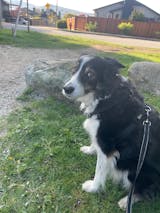4 Fun Ways to Work-Out with Your Dog

Your dog loves to and wants to move. Whether it’s playing tag in the backyard, your daily morning dog walk, or going out for a hike in the woods – your dog is happy to work-out with you.
We want you to embrace this joy for movement and have put together our 4 favorite ways to work-out with your dog.
This movement and working out with your dog helps keep your dog’s joints healthy, encourages a healthy weight (for you and your dog), supports your dog’s mental health, and gives both of you all-important bonding time.
Before starting a new work-out with your dog, it’s important you honestly think about your dog’s current level of fitness and age. If your dog is not used to running, hiking, or agility games – it’s very important you start slowly.
As well, you need to be aware of your dog’s age and any current health conditions. If you have a senior dog with joint health concerns or have some doubt about what your dog should be doing – please consult your veterinarian.
Above all else, when working out with your dog, you don’t want to do anything that causes your dog to become injured.
Read on for our 4 suggestions on how you can work-out with your dog.
How to Run with Your Dog
To run with your dog, it’s super important that you’re aware of your dog’s current fitness level.
Just as you’ll develop injuries and muscle soreness by doing too much running too soon – the same applies to your dog.
Here are some tips on how to run with your dog:
- Don’t start running with your puppy. Your puppy shouldn’t start running with you until his bones stop growing. This really depends on the breed and size of your dog. Discuss this with your veterinarian.
- Start slowly. Pay attention to your dog’s breathing. In fact, it’s best to start with a walk-run routine.
- Keep the runs short. Slowly add running to your dog’s routine with 10 or 15-minute-long easy runs a couple of times a week.
- Use a leash and comfortable harness. Look for a leash/harness combination that is designed for running.
- Don’t let your dog run all-over the path or running trail.
- Remember to keep your dog hydrated. And don’t feed your dog a big meal before you go out for your run.
How to Participate in Agility Games with Your Dog
One of the best ways to participate in agility games with your dog is to join a local dog agility club.
Look for an agility club that has a certified dog agility trainer. Discuss how your dog will be trained on the agility games. Ask questions about the types of agility games that are appropriate for your dog’s breed and size.
With the right training and environment, your dog will soon be hooked on playing on the dog walk, running through tunnels, weaving around poles, jumping through hoops or tires, and even balancing on a teeter board.
How to Hike with Your Dog
To start hiking with your dog, it’s important you do some planning and preparation. Regardless of the type and length of trail hike you plan on, it’s key that both you and your dog are prepared for the outdoors.

To hike with your dog, remember the following tips:
- Choose a trail that is not overly rugged. Start slowly with an easy to hike trail that is mostly flat and not very long.
- Use a leash and harness. Make sure the leash and harness are comfortable and give both of you a sense of control. Look for a leash/harness set-up that is designed for an active dog.
- Bring water and food for both you and your dog. There are lots of portable and collapsible dog bowls that make it easy for your dog to drink water on the trail.
- Tell someone where you’re going and when you plan to be home. Don’t change your plans mid-way through the hike.
- Remember to think about your overall safety – bring a map, water, cell phone, jacket, etc.
- Think of your dog’s feet. Pay attention to the trail surface and make sure it’s not too hard on your dog’s tender paws.
- Slow down and enjoy being in nature, reap the mental health benefits for you and your dog. Give your dog all the breaks he needs and don’t push him too hard or long.
How to Camp with Your Dog
When it comes to camping with your dog, it’s all about enjoying the great outdoors. And yes, camping with your dog is a work-out.
It’s very important that you choose a campsite that is dog-friendly. Don’t assume that every campsite or park accepts dogs. Read the rules and regulations for the campsite and if you’re in doubt – ask questions.
Bring a tent that is big enough for you and your dog to sleep in comfortably. No one wants to be crowded in an overstuffed tent.
Remember that when you’re at your campsite, you need to keep your dog leashed. Dogs are naturally curious, and it only takes a split-second for your dog to be distracted and wander off.
Bring a first aid kit for yourself and for your dog. Talk to your vet about the right types of bandages and other gear you should include in your first aid kit.
Don’t forget that the weather is out of your control. Bring extra towels, dog coats, booties, and blankets.
How to Play Flyball with Your Dog
Because flyball is a team sport, you need to join your local flyball club. Flyball is a super active and exciting sport for dogs of all breeds and sizes.
However, before you enroll your dog in flyball training class, it’s important you discuss this with your veterinarian. Because flyball is super-fast and requires a lot of dog agility, you need to make sure your dog’s joint health can sustain this activity level.
Flyball is a dog relay race. Typically, two teams of dogs compete side-by-side with each dog on the team taking a turn running and jumping through a flyball course to retrieve a tennis ball.
The cool twist on this sport is that to get the tennis ball, your dog must jump and land on a spring-loaded box that releases the ball.
Working Out with Your Dog
Above all else, it’s key that whatever sport or activity you choose is enjoyable for both you and your dog. If your dog doesn’t enjoy running or resists participating in agility games – don’t force your dog.
Have fun and explore different ways to stay active with your dog. You just might discover that your dog’s favorite ways of working out with you include playing fetch in the backyard or going on long daily walks in your neighborhood looking for new smells.
Remember to pay attention to how your dog is moving before, during, and after your runs, hikes, or sessions at the flyball or agility club. Your dog is very stoic and will do his best to hide any joint discomfort or other injury.
If you’re unsure about how your dog is responding to your new work-out routine – schedule a visit with your veterinarian.
Visit the Leaps & Bounds Facebook community page and tell us how you work-out with your dog. Share your top tips on how you keep working out fun for both you and your dog.




